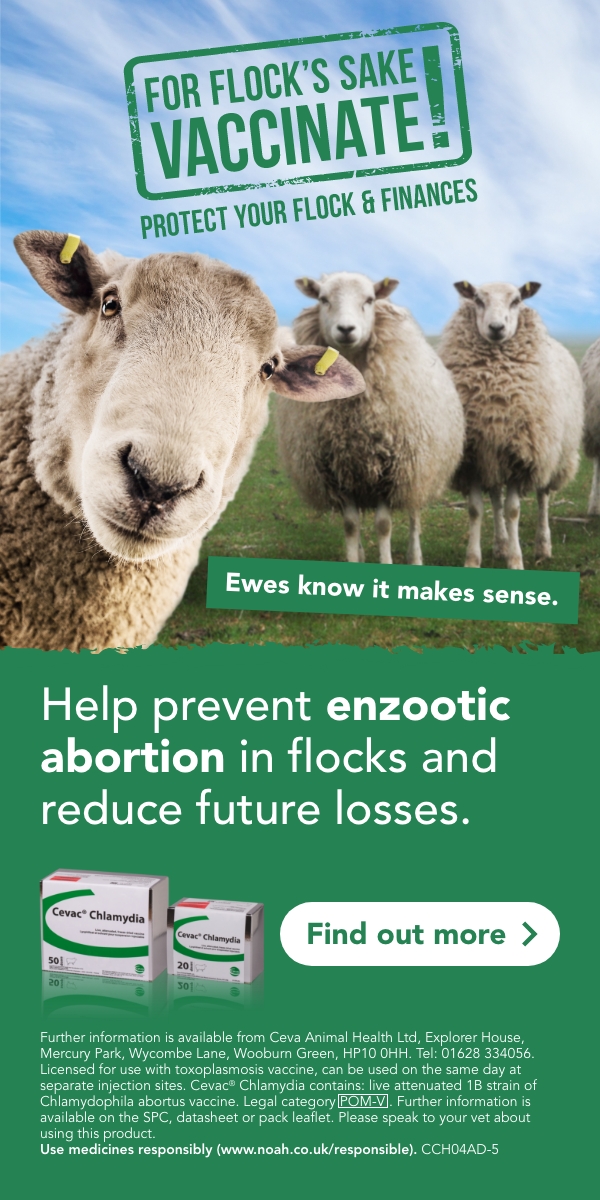Vaginal prolapse
Vaginal prolapse occurs during the last month of pregnancy. It is typically seen in around 1% (1 in 100) of pregnant sheep but may affect up to 15% of sheep within a flock. Any ewes which have prolapsed must be clearly identified and culled at the end of the season as they will most likely re-prolapse if allowed to breed again.
Many factors have been implicated in the cause of vaginal prolapse including:
- Excessive body condition (BCS 4 and above on a scale of 1-5)
- Multiple lambs in utero
- High fibre diets, particularly those containing root crops
- Limited exercise in housed ewes
- Lameness leading to prolonged periods lying down
- Short-docked tails (although vaginal prolapses are also seen in undocked mountain breeds)
- Steep fields
- Sub-clinical hypocalcaemia
The size of a vaginal prolapse can vary from a small area of dorsal vaginal wall to a larger structure of up to 20 cm when the prolapse may contain urinary bladder, uterine horn(s) or both of these structures.

Figure 1: A vaginal prolapse extending for 10-12 cm.

Figure 2: The diameter of this vaginal prolapse extends to 20 cm and it contains the urinary bladder

Figure 3: Short-docked tails have been implicated in vaginal prolapse.
Ewes with vaginal prolapse may show many behavioural signs consistent with first stage labour including:
- Isolation from the remainder of the flock
- Failure to come forward for concentrate feeding
- Long periods spend lying on their side with repeated, short-duration, forceful abdominal straining and associated vocalisation

Figure 4: Ewe straining with a vaginal prolapse showing behaviour consistent with first stage labour
The length of time the prolapse has been present directly affects the degree of contamination (with faeces, bedding material, soil etc.), the damage to the vaginal tissue and therefore the overall outcome of the case. If it is not noticed and addressed promptly the vaginal wall can quickly become swollen and friable, which greatly increases the risk of tears or rupture during manual replacement. Compromised blood supply to the tissue will eventually result in necrosis. Prognosis in these cases is hopeless and the ewe should be euthanased.
Treatment of vaginal prolapse
If it is necessary to transport sheep with vaginal prolapse to the veterinary surgery, then the prolapse should be covered with a towel soaked in warm water to prevent further contamination and damage.
Effective caudal analgesia (epidural injection of lignocaine) administered by a veterinary surgeon greatly aids replacement of the vaginal prolapse. Emptying of the bladder can then be readily achieved in the standing ewe by raising the prolapse relative to the vulva thereby reducing the fold in the neck of the bladder at which point urine is able to flow freely.

Figure 5: The prolapse should be carefully cleaned in warm water containing disinfectant solution.
The vaginal prolapse should be replaced with the ewe standing; in some cases the vaginal prolapse will return to the normal position within five minutes once the epidural has taken effect and the ewe has stopped straining. If not, gentle pressure around the prolapse coupled with the use of obstetrical lubricant will help to invert the vagina again. There is no reason to suspend the ewe by the hind limbs to replace a vaginal prolapse.

Figure 6: Administration of local anaesthetic to block straining by the ewe.
An anti-inflammatory drug will be administered by the vet to reduce pain. Antibiotics may be given if there is evidence of infection or severe tissue damage. Your vet will advise which drug is most suitable, and the correct route and course of administration.
Methods of retention after replacement of vaginal prolapse
Methods of retention after replacement of vaginal prolapse include the Buhner suture, plastic retention devices and harnesses or trusses.
Buhner suture
A modified Buhner suture of 5 mm nylon tape is placed in the tissue around the vulva 2 cm from the labia and tightened to allow an opening of 1.5 cm diameter (two fingers’ width). The modified Buhner suture can easily be untied to allow examination of the vulva and vagina for signs of first stage labour. This method of retention should only ever be used by a veterinary surgeon using the appropriate equipment and pain relief.

Figure 7: Pain-free insertion of a Buhner suture using epidural anaesthesia.

Figure 8: Buhner suture is tightened to allow an opening of 1.5 cm diameter (one-two fingers).
The Buhner suture should be untied well before the expected lambing date, which can be estimated from the ewe’s keel mark, monitoring of the ligaments around the tail head which slacken close to lambing, and udder development and accumulation of colostrum in the teats.
Ewes should also be monitored for the signs of the first stage of labour in case estimated lambing dates prove inaccurate. These include:
- separation from the remainder of the group,
- inappetance,
- frequent getting up and lying down,
- sniffing at the ground, and abdominal straining
- foetal membranes present at the vulva.
If the cervix has already fully dilated, and first stage labour completed before the ewe is noticed, a lamb may be forcefully expelled as soon as the retention suture has been slackened.

Fig 9: The Buhner suture must be released before the expected lambing date. Note the foetal membranes indicating first stage labour in this ewe.
Sutures which penetrate into the vagina, must be avoided as urine scalding around the suture material and secondary bacterial infection lead to discomfort and straining, making re-prolapse much more likely.
All ewes with retention sutures for vaginal prolapse must be clearly identified and staff notified that there could be problems at lambing with these sheep. Permanent ewe identification is essential to ensure culling before the next breeding season.
Plastic retention devices
Plastic retention devices are shaped such that the central loop is placed within the vagina which is then held within the pelvic canal by the two side arms tightly tied to the fleece of the flanks. These devices can work well in mild early cases, but in more severe cases where the ewe is straining and prolapsing despite the presence of the device veterinary advice should be sought.

Fig 10: Plastic retention devices can work well in mild early cases.

Figure 11: The plastic retention device is not working in this case - effective pain relief is essential in such cases; veterinary advice must be sought.
Harnesses or trusses

Figure 12: Effective management of a vaginal prolapse in a Blueface Leicester ewe using a truss.
Harnesses and trusses are very useful in situations where the prolapse is detected early and there is little superficial trauma/contamination. Harnesses and trusses must be fitted carefully, and inspected regularly, to prevent pressure sores.
Complications resulting from vaginal prolapse
Complications resulting from vaginal prolapse include:
- Abortion
- Incomplete cervical dilation with possible prolapse during lambing
- Death of lambs causing death of the ewe
Abortion
Abortion may occur 24 to 48 hours after replacement of the vaginal prolapse. It is not known whether this event is a consequence of trauma to the placenta during prolapse or other factors. Ewes must be confined and carefully supervised after replacement of prolapses for signs of impending abortion.
Incomplete cervical dilation
Trauma, infection and swelling of the vaginal tissue of the prolapse may result in incomplete cervical dilation (ringwomb) during first stage labour. In this situation typical ringwomb management strategies e.g. the use of muscle relaxants and calcium will not work, and if the cervix does not respond to gentle manipulation with a clean, gloved hand, then the lamb(s) should be delivered by caesarean section.

Figure 13: Trauma and swelling of the vaginal prolapse may result in ringwomb during first stage labour.
Death of the ewe
Lambs which die because of a vaginal prolapse and are subsequently not expelled promptly may cause death of the ewe due to toxaemia and sepsis. Ewes which have prolapsed must be closely monitored for signs of labour or ill health, and appropriate action taken in a timely fashion.

Figure 14: Ewe with bloated abdomen caused by a gas-filled uterus containing rotten lambs shortly before euthanasia.
Uterine Prolapse
Uterine prolapse affects approximately 0.1% (1 in 1000) of ewes during lambing. The prolapse may occur either immediately after lambing or after an interval of 12 to 48 hours. In the first instance prolapse usually occurs as a consequence of prolonged second stage labour and the delivery of a large singleton lamb.
Uterine prolapse occurring after an interval of 12 to 48 hours generally results from straining caused by pain arising from infection and swelling of the vagina and vulva which have developed consequent to assisted delivery of the lamb(s).

Figure 15: Uterine prolapse following the birth of a large single lamb.

Fig 16: Uterine prolapse occurring 48 hours after an assisted lambing. Straining caused by pain from infection and swelling of the vagina and vulva caused the prolapse.
The everted uterus is readily identifiable by its large size (up to 50 cm long and 25 cm in diameter) extending from the vulva to below the level of the hocks with prominent caruncles (raised circular areas where the placenta was attached to the uterus) and adherent foetal membranes.
Unless the uterus is replaced correctly and fully inverted to its normal position within the abdomen, the ewe will continue to strain and re-prolapse. A uterine prolapse is best replaced by a veterinary surgeon under appropriate epidural anaesthesia.

Figure 17: Successful replacement of the uterine prolapse featured in the image above.
A Buhner suture of 5mm nylon tape is the best way to ensure the uterus remains in place (see method for retention of vaginal prolapse above). Antibiotics should be administered after replacement of the uterine prolapse to limit bacterial infection of the traumatised tissues. Your vet will prescribe the most appropriate antibiotics and anti-inflammatory drugs to use.
The ewe's milk yield might be reduced for several days after replacement of the uterine prolapse and her lambs may require supplementary feeding. Unlike vaginal prolapse, it is unusual for a ewe to prolapse the uterus the following year and there is no indication to prematurely cull such ewes.
Evisceration through vaginal tear
In rare cases evisceration of intestines through a tear in the vaginal wall occurs spontaneously in heavily pregnant ewes during the last month of gestation.

Figure 18: Evisceration of intestines through a tear in the dorsal vaginal wall.
There is usually no history of prior vaginal prolapse or straining. The incidence may reach 1-2 per cent in some housed flocks. Excessive body condition, triplet pregnancy, and high fibre diets are thought to be risk factors, but the precise mechanism is not known.
Ensure all ewes, particularly the fecund breeds, are in the correct condition at tupping to reduce the number of high multiple births and lower the risk of vaginal wall rupture. Reverse flushing could be considered for ewes with the Inverdale gene.
There is no treatment and affected ewes must be euthanased immediately.


